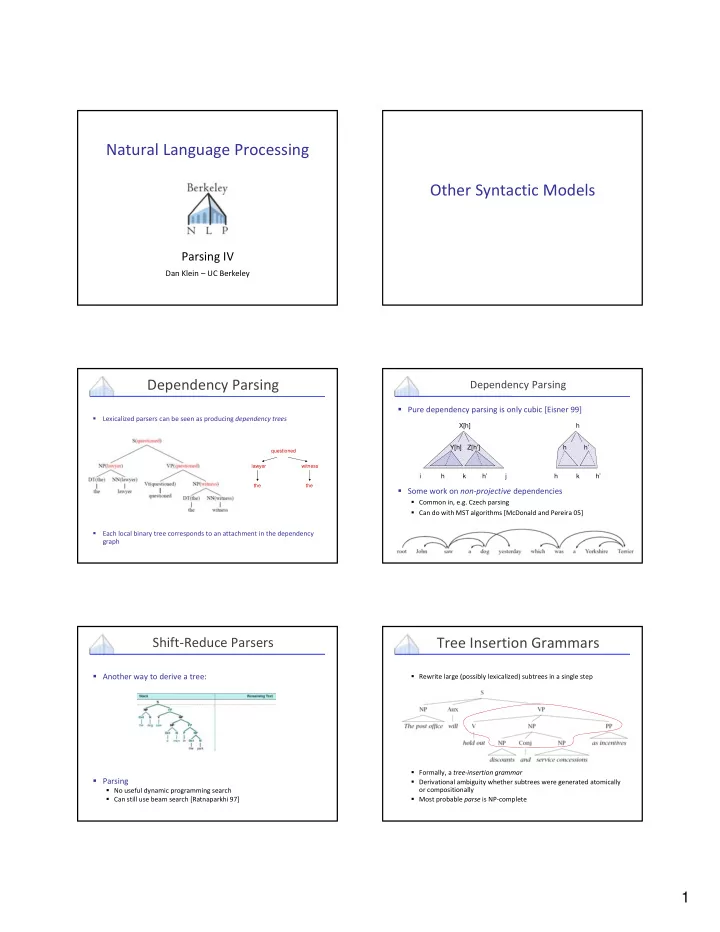

Natural Language Processing Other Syntactic Models Parsing IV Dan Klein – UC Berkeley Dependency Parsing Dependency Parsing Pure dependency parsing is only cubic [Eisner 99] Lexicalized parsers can be seen as producing dependency trees X[h] h Y[h] Z[h’] h h’ questioned lawyer witness i h k h’ j h k h’ the the Some work on non ‐ projective dependencies Common in, e.g. Czech parsing Can do with MST algorithms [McDonald and Pereira 05] Each local binary tree corresponds to an attachment in the dependency graph Shift ‐ Reduce Parsers Tree Insertion Grammars Another way to derive a tree: Rewrite large (possibly lexicalized) subtrees in a single step Formally, a tree ‐ insertion grammar Parsing Derivational ambiguity whether subtrees were generated atomically No useful dynamic programming search or compositionally Can still use beam search [Ratnaparkhi 97] Most probable parse is NP ‐ complete 1
TIG: Insertion Tree ‐ adjoining grammars Start with local trees Can insert structure with adjunction operators Mildly context ‐ sensitive Models long ‐ distance dependencies naturally … as well as other weird stuff that CFGs don’t capture well (e.g. cross ‐ serial dependencies) TAG: Long Distance CCG Parsing Combinatory Categorial Grammar Fully (mono ‐ ) lexicalized grammar Categories encode argument sequences Very closely related to the lambda calculus (more later) Can have spurious ambiguities (why?) Empty Elements In the PTB, three kinds of empty elements: Null items (usually complementizers) Dislocation (WH ‐ traces, topicalization, relative clause and heavy NP extraposition) Empty Elements Control (raising, passives, control, shared argumentation) Need to reconstruct these (and resolve any indexation) 2
Example: English Example: German Types of Empties A Pattern ‐ Matching Approach [Johnson 02] Pattern ‐ Matching Details Top Patterns Extracted Something like transformation ‐ based learning Extract patterns Details: transitive verb marking, auxiliaries Details: legal subtrees Rank patterns Pruning ranking: by correct / match rate Application priority: by depth Pre ‐ order traversal Greedy match 3
Results Semantic Roles Semantic Role Labeling (SRL) SRL Example Characterize clauses as relations with roles : Says more than which NP is the subject (but not much more): Relations like subject are syntactic, relations like agent or message are semantic Typical pipeline: Parse, then label roles Almost all errors locked in by parser Really, SRL is quite a lot easier than parsing PropBank / FrameNet PropBank Example FrameNet: roles shared between verbs PropBank: each verb has its own roles PropBank more used, because it’s layered over the treebank (and so has greater coverage, plus parses) Note: some linguistic theories postulate fewer roles than FrameNet (e.g. 5 ‐ 20 total: agent, patient, instrument, etc.) 4
PropBank Example PropBank Example Shared Arguments Path Features Results Empties and SRL Features: Path from target to filler Filler’s syntactic type, headword, case Target’s identity Sentence voice, etc. Lots of other second ‐ order features Gold vs parsed source trees SRL is fairly easy on gold trees Harder on automatic parses 5
Recommend
More recommend